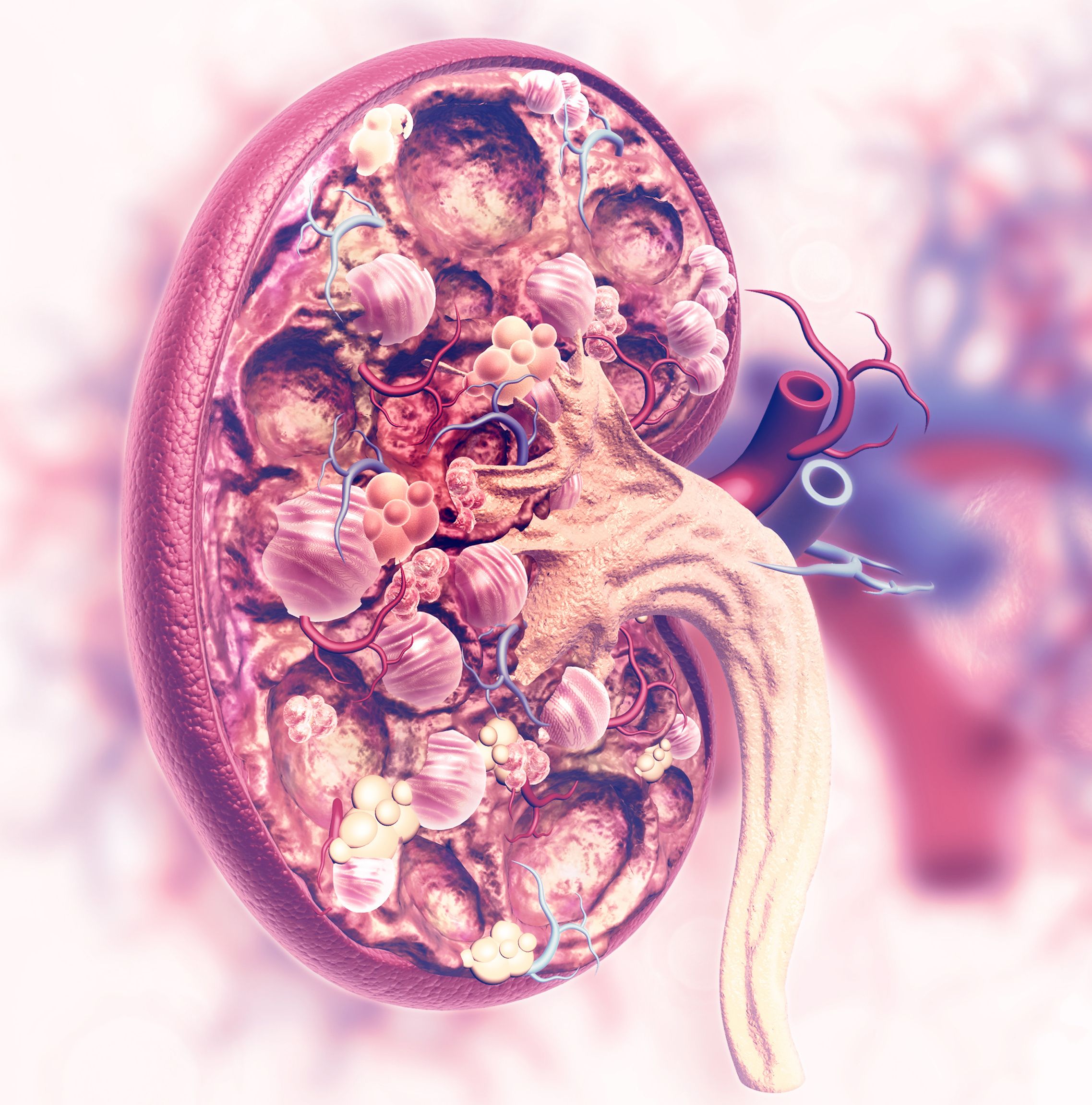Pembrolizumab/Axitinib Improves Survival vs Sunitinib in Advanced RCC
The biomarker analysis in KEYNOTE-426 showed that pembrolizumab plus axitinib therapy is associated with positive outcomes with angiogenesis in RCC.
The biomarker analysis in KEYNOTE-426 showed that pembrolizumab plus axitinib therapy is associated with positive outcomes with angiogenesis in RCC.

Pembrolizumab (Keytruda) plus axitinib (Inlyta) yielded a durable and sustained clinical benefit vs sunitinib (Sutent) in patients with advanced renal cell carcinoma (RCC), according to interim results from the phase 3 KEYNOTE-426 trial (NCT02853331) published in Nature Medicine.1
The median overall survival (OS) was 47.2 months (95% CI, 43.6-54.8) in the pembrolizumab plus axitinib arm compared with 40.8 months (95% CI, 34.3-47.5) in the sunitinib arm (HR, 0.84; 95% CI, 0.71-0.99). The median progression-free survival (PFS) was 15.7 months (95% CI, 13.6-20.2) with the combination treatment vs 11.1 months (95% CI, 8.9-12.5) with sunitinib (HR, 0.69; 95% CI, 0.59-0.81). The OS and PFS benefits were consistent across subgroups, such as those with International Metastatic RCC Database Consortium (IMDC) risk favorable, intermediate-risk, and poor-risk categories, and those with PD-L1 combined positive score (CPS) cutoff values of less than 1 and 1 or more.
In the pembrolizumab plus axitinib arm, the confirmed overall response rate (ORR) was 60.6%, with complete responses (CRs) in 11.6% and partial responses (PRs) in 49.1%; in the sunitinib arm, the confirmed ORR was 39.6%, with CRs in 4.0% and PRs in 35.7%. The median duration of response was 23.6 months (range, 1.4+ to 68.6+) vs 15.3 months (range, 2.3-68.3), respectively. It was estimated that 26.0% of the pembrolizumab plus axitinib arm and 14.4% of the sunitinib arm would have an ongoing objective response at 60 months.
In a post hoc analysis of patients who received 35 cycles of pembrolizumab (n = 120), the median OS was not reached (NR; 95% CI, 70.6-NR), with estimated 48- and 60-month OS rates of 81.7% and 70.7%. The median PFS was 37.4 months (95% CI, 32.3-43.7), with estimated 48- and 60-month OS rates of 38.3% and 32.8%. The confirmed ORR was 85.0%, with CRs in 18.3% and PRs in 66.7%.
“KEYNOTE-426 was the first trial to combine a PD-1 inhibitor immunotherapy [pembrolizumab] with a VEGF receptor inhibitor antiangiogenic drug [axitinib] in the first-line setting for advanced [RCC]. It therefore has the longest follow-up duration among the various trials comparing these types of drug combinations,” Brian Rini, MD, chief of clinical trials at Vanderbilt-Ingram Cancer Center and Ingram Professor of Medicine at Vanderbilt University, lead author of the study, said in a press release.2 “Before the development of antiangiogenic drugs and immunotherapies, advanced renal cell carcinoma had a very poor prognosis. These drug combinations have dramatically improved treatment options and outcomes for patients.”
In KEYNOTE-426, a total of 861 patients were randomly assigned, in a 1:1 ratio, to receive either pembrolizumab plus axitinib (n = 432) or sunitinib monotherapy (n = 429). Treatment consisted of 200 mg of intravenous pembrolizumab once every 3 weeks for up to 35 cycles plus 5 mg of oral axitinib twice daily, or 50 mg of oral sunitinib once daily for 4 weeks on and 2 weeks off, continuously.
Eligible patients had newly diagnosed stage IV or recurrent clear cell RCC that had not received systemic therapy for advanced disease, a Karnofsky Performance Scale score of 70% or higher at baseline, and at least 1 measurable lesion per RECIST 1.1.
The trial’s dual primary end points were OS and PFS per RECIST 1.1 by blinded independent central review, and confirmed ORR was a key secondary end point; all 3 were met at the first interim analysis.3
The prespecified objectives of the exploratory biomarker analysis were to assess whether an IFNγ-related 18-gene TcellinfGEP and 10 other signatures were individually associated with clinical outcomes with either treatment; whether prespecified molecular subtypes as categorical variables were associated with clinical outcomes; whether continuous PD-L1 CPS is separately associated with clinical outcomes; and whether mutation status of key RCC driver genes are separately associated with clinical outcomes.
Regarding biomarkers, OS and PFS were both favored with the combination in the RNA sequencing and whole-exome sequencing analyses populations. Higher TcellinfGEP was associated with improved OS (P = .002), PFS (P <.0001), and ORR (P <.0001); there were no associations with TcellinfGEP and clinical outcomes in the sunitinib arm.
With the angiogenesis signature, the combination treatment was associated with positive outcomes for OS (P = .004); sunitinib was positively associated with OS (P <.0001), PFS (P <.0001), and ORR (P = .003). PD-L1 CPS was not associated with a change in clinical outcomes with the combination treatment (P >.05); with sunitinib, PD-L1 CPS was negatively associated with OS (P = .025).
“There is an unmet need for biomarkers that are predictive of patient outcomes following treatment with available first-line therapies for advanced renal cell carcinoma,” Rini stated.2 “Although our analysis showed potential clinical utility of some RNA signatures in identifying patients who are likely to benefit the most from each treatment, further prospective clinical studies are needed.”
References
- Rini BI, Plimack ER, Stus V, et al. Pembrolizumab plus axitinib versus sunitinib for advanced clear cell renal cell carcinoma: 5-year survival and biomarker analyses of the phase 3 KEYNOTE-426 trial. Nat Med. Published online August 1, 2025. doi:10.1038/s41591-025-03867-5
- Study reports final clinical trial data for advanced kidney cancer treatment. News release. Vanderbilt University Medical Center News. August 1, 2025. Accessed August 1, 2025. https://tinyurl.com/4xdbr793
- Rini BI, Plimack ER, Stus V, et al. Pembrolizumab plus axitinib versus sunitinib for advanced renal-cell carcinoma. N Engl J Med. 2019;380(12):1116-1127. doi:10.1056/NEJMoa1816714